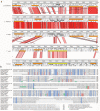Comparative genomic analysis of three Leishmania species that cause diverse human disease
- PMID: 17572675
- PMCID: PMC2592530
- DOI: 10.1038/ng2053
Comparative genomic analysis of three Leishmania species that cause diverse human disease
Abstract
Leishmania parasites cause a broad spectrum of clinical disease. Here we report the sequencing of the genomes of two species of Leishmania: Leishmania infantum and Leishmania braziliensis. The comparison of these sequences with the published genome of Leishmania major reveals marked conservation of synteny and identifies only approximately 200 genes with a differential distribution between the three species. L. braziliensis, contrary to Leishmania species examined so far, possesses components of a putative RNA-mediated interference pathway, telomere-associated transposable elements and spliced leader-associated SLACS retrotransposons. We show that pseudogene formation and gene loss are the principal forces shaping the different genomes. Genes that are differentially distributed between the species encode proteins implicated in host-pathogen interactions and parasite survival in the macrophage.
Figures


References
-
- Marsden PD. Mucosal leishmaniasis (‘espundia’ Escomel, 1911) Trans. R. Soc. Trop. Med. Hyg. 1986;80:859–876. - PubMed
-
- Lipoldova M, Demant P. Genetic susceptibility to infectious disease: lessons from mouse models of leishmaniasis. Nat. Rev. Genet. 2006;7:294–305. - PubMed
-
- Berriman M, et al. The genome of the African trypanosome Trypanosoma brucei. Science. 2005;309:416–422. - PubMed
-
- El-Sayed NM, et al. The genome sequence of Trypanosoma cruzi, etiologic agent of Chagas disease. Science. 2005;309:409–415. - PubMed
Publication types
MeSH terms
Associated data
- Actions
- Actions
- Actions
- Actions
- Actions
- Actions
- Actions
- Actions
- Actions
- Actions
- Actions
- Actions
- Actions
- Actions
- Actions
- Actions
- Actions
- Actions
- Actions
- Actions
- Actions
- Actions
- Actions
- Actions
- Actions
- Actions
- Actions
- Actions
- Actions
- Actions
- Actions
- Actions
- Actions
- Actions
- Actions
- Actions
- Actions
- Actions
- Actions
- Actions
- Actions
- Actions
- Actions
- Actions
- Actions
- Actions
- Actions
- Actions
- Actions
- Actions
- Actions
- Actions
- Actions
- Actions
- Actions
- Actions
- Actions
- Actions
- Actions
- Actions
- Actions
- Actions
- Actions
- Actions
- Actions
- Actions
- Actions
- Actions
- Actions
- Actions
- Actions
Grants and funding
LinkOut - more resources
Full Text Sources
Other Literature Sources
Medical
Molecular Biology Databases

